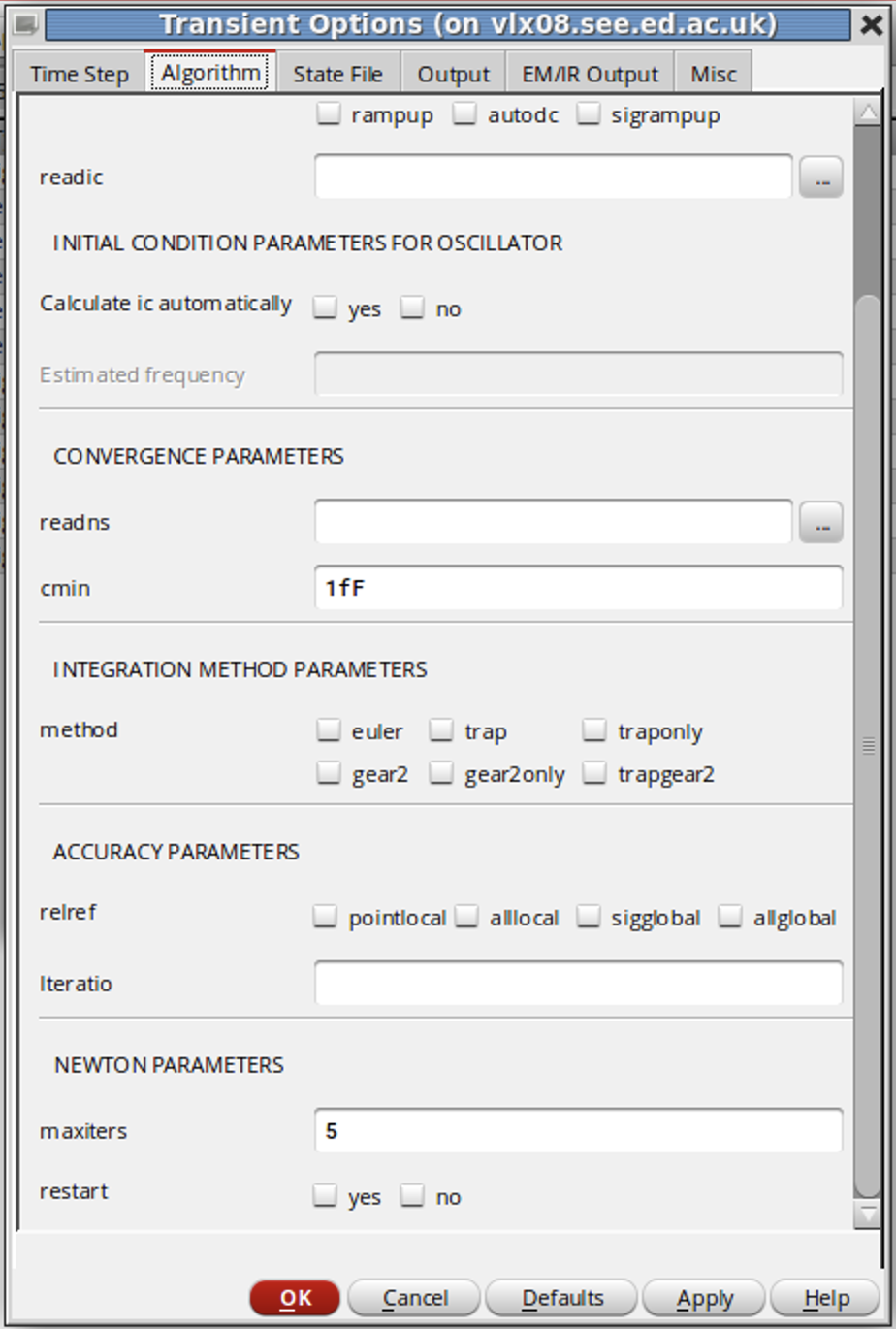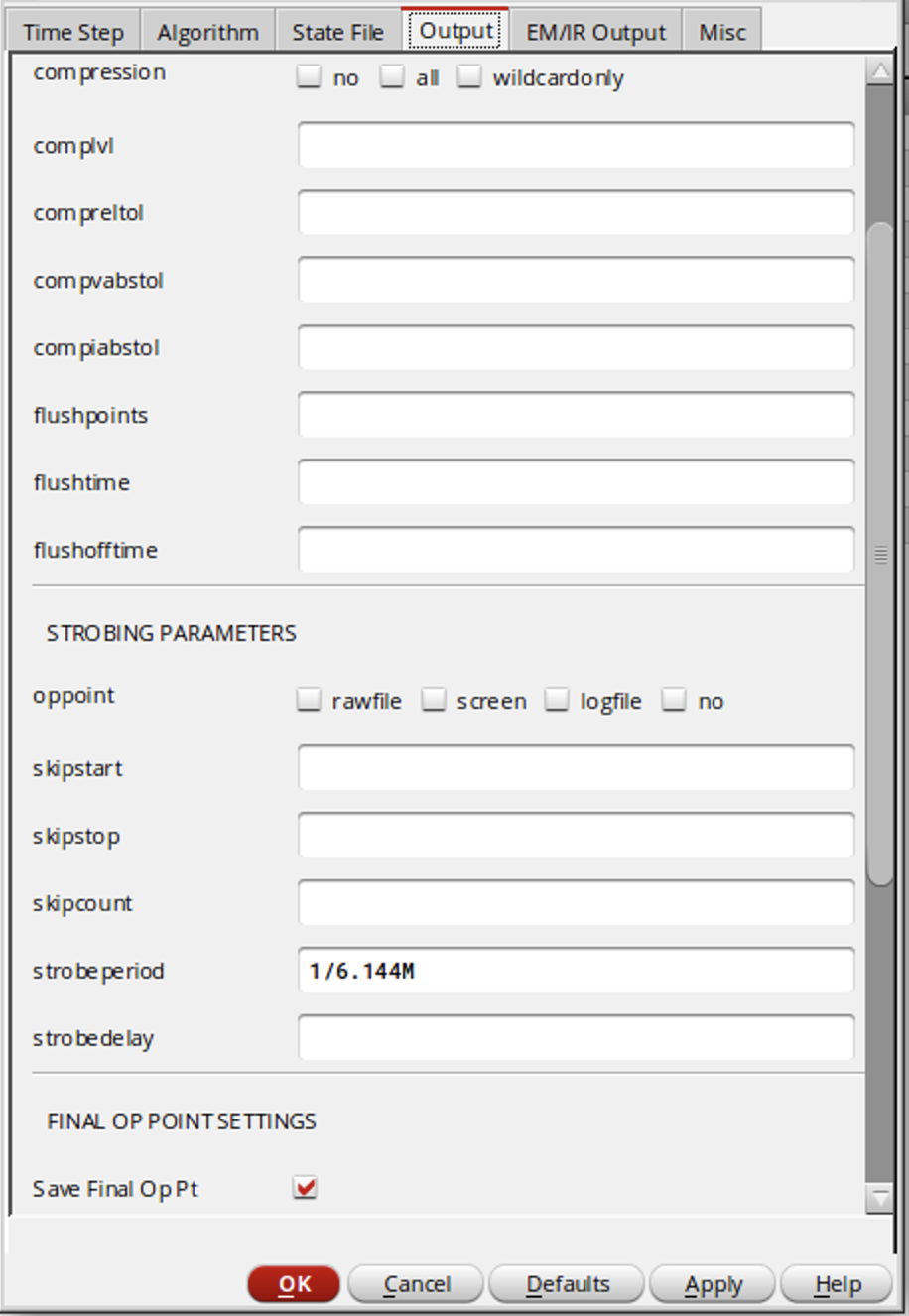Cadence Virtuoso Simulation Tips (Updating)
1. Some parameter settings in Transient simulation
Reference: https://web.engr.oregonstate.edu/~moon/kaj/cadence.html#top
Accuracy
There are some parameters that are useful but confusing when I do Transient simulation, so I did the research and figured out some of them. These settings can be found when you click the “Option” button and they will determine the behaviour of the simulation.

Shown above, in the INTEGRSTION PARAMETERS column, it lists some methods which specifies the integration method, and it will also determine the accuracy and simulation speed. Also, the ACCURACY PARAMETERS column also lists some parameters which can affect the accuracy. Remember! Never set this things by yourself unless you want a unreliable results! What you need to so is set the “errpreset” at the beginning of Transient simulation setting page which concluded three options: liberal, moderate and conservative, and they will specifies the parameters related to the accuracy, shown as below.

“liberal” is the most inaccurate one, while the “conservative” has the highest accuracy.
Convergence
In the CONVERGENCE PARAMETERS column, the parameter “cmin” which stands for the minimum capacitance to ground at each node can be set to a physically reasonable non-zero value to help converge the simulation. For example, in my simulation, I set it to $1 fF$.
Strobing
Strobing is a method to reduce the number of output data points, and it can also be used for sampling the ouput. Therefore, that’s why it’s useful in ADC verfication.

There are parameters that you can set: “strobeperiod” : sets the interval between points that you want to save. “strobedelay” : sets the offset within the period relative to ‘skipstart’. “skipcount” : If this is set to N, then only every N’th point is saved. Normally, I set the strobeperiod to sampling time of ADC I’m testing.
2. The difference between Harmonic Balance & Shooting in PSS simulation
Reference: https://community.cadence.com/cadence_blogs_8/b/rf/posts/tip-of-the-week-when-to-use-harmonic-balance-engine-vs-shooting-newton-engine
They are two simulation engines in the PSS setting, and an inappropriate setting can lead to the “no convergence” issue of simulation.
Based on Tawna’s(author of the reference) description:
The Shooting Newton algorithm uses an adaptive time step control, which is particularly effective for sharp transitions. Convergence is robust and not as sensitive to model imperfections.
Harmonic balance (HB) is much faster for mildly nonlinear circuits.
Conclusion:
These two engines have different algorithms, and if your circuit is mildly nonlinear, HB is more recommended because it’s faster than Shooting. It looks like the Shotting is easier to get convergence because normally non-convergence is caused by non-linearity. The results should be similar if the simulation parameter setting is properly.
Tawna also listed some cases that are suitable for each engine(I just copy them):
For Harmonics Balance:
- High dynamic range, weakly-nonlinear systems
- RF front-ends (LNA, Mixer)
- IQ modulators
- Mildly nonlinear oscillators with resonators, such as
- LC oscillators
- Crystal oscillators
- Negative-gain oscillators
- Circuits with distributed components
- Transmission lines
- S-parameter models
For Shooting Newton:
-
Circuits where input signals have sharp transitions
-
Strongly nonlinear circuits
-
Frequency dividers
-
Strongly-nonlinear resonatorless oscillators, such as
- Ring oscillators,
- Relaxation oscillators,
- Oscillators containing digital control components,
- Oscillators with dividers.
-
Copyright Statement
This article is an Original Work of Bohao, if reprinted, please indicate the source: http:/merenguelee.github.io/2023/07/19/Cadence-Virtuoso-Simulation-Tips-(Updating)/